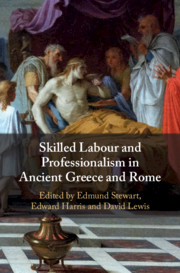Book contents
- Skilled Labour and Professionalism in Ancient Greece and Rome
- Skilled Labour and Professionalism in Ancient Greece and Rome
- Copyright page
- Contents
- Illustrations
- Contributors
- Acknowledgements
- Abbreviations
- Introduction
- Part I Professionals and Professional Identity in Greece and Rome
- Part II Specialization and the Division of Labour in the Ancient City
- Part III Case Studies of Professions 1: Sculpture
- 6 Professionalism in Archaic and Classical Sculpture in Athens: The Price of Technē
- 7 Artists beyond Athens: The Freedoms and Restrictions of the Artistic Profession in Classical Greece
- 8 Roman Sculptors at Work: Professional Practitioners?
- Part IV Case Studies of Professions 2: Music and Athletics
- Part V Case Studies of Professions 3: A Profession of Arms?
- Index
- References
8 - Roman Sculptors at Work: Professional Practitioners?
from Part III - Case Studies of Professions 1: Sculpture
Published online by Cambridge University Press: 18 September 2020
- Skilled Labour and Professionalism in Ancient Greece and Rome
- Skilled Labour and Professionalism in Ancient Greece and Rome
- Copyright page
- Contents
- Illustrations
- Contributors
- Acknowledgements
- Abbreviations
- Introduction
- Part I Professionals and Professional Identity in Greece and Rome
- Part II Specialization and the Division of Labour in the Ancient City
- Part III Case Studies of Professions 1: Sculpture
- 6 Professionalism in Archaic and Classical Sculpture in Athens: The Price of Technē
- 7 Artists beyond Athens: The Freedoms and Restrictions of the Artistic Profession in Classical Greece
- 8 Roman Sculptors at Work: Professional Practitioners?
- Part IV Case Studies of Professions 2: Music and Athletics
- Part V Case Studies of Professions 3: A Profession of Arms?
- Index
- References
Summary
This chapter concerns Roman sculptors and considers whether sculptors in the Roman empire fit the modern criteria for the term ‘professional’, as has been developed in the sociology of modern professions. While the lack of a regulatory system governing stone carving practitioners in the Roman world might make it hard to fit them into most modern definitions of professionals, it is argued that Roman sculptors saw their work as skilled and used their specialist knowledge to obtain social and economic rewards.
- Type
- Chapter
- Information
- Skilled Labour and Professionalism in Ancient Greece and Rome , pp. 243 - 266Publisher: Cambridge University PressPrint publication year: 2020
References
- 2
- Cited by



